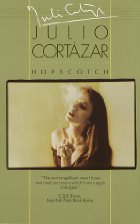
In case you're just joining in, I'm spending this week writing about Julio Cortázar's experimental 1963 novel Hopscotch. For an idea of what I loved and hated in the book, please visit my posts from Tuesday and Thursday. On Tuesday I also summarized the novel's unique structure (I think this is the first time I've ever quoted myself on my own blog!):
Cortázar offers his readers two choices of how to read his book: you can start at Chapter 1 and progress as normal to Chapter 56, stopping there and discarding the final 200 pages of the book (which contain Chapters 57-155, the "expendable" chapters). Or, you can follow a leap-frogging list that begins with Chapter 73, progresses to Chapter 1, and continues vaulting back and forth between the necessary and expendable sections until you've eventually read the entire book...or have you?
Which leads us to today's topic:
3. Effects of the Narrative Structure
I didn't want to write a Hopscotch review that ignored the psychological effects of zig-zagging through a text according to an unpredictable, non-linear program. The first thing I noticed was that flipping through the book after every chapter (and many chapters are quite short) obviously disrupts the reading experience. It's more difficult to get into the swing of things if one is constantly paging around, which makes Cortázar's occasional longer chapters, with their concentrated bursts of narrative brilliance, that much more striking. On the flip side, finding a new location after almost every chapter also forces the reader to pause for a few seconds and think about the chapter she's just read. As I spent more time with Hopscotch, I came to an appreciation of this built-in period of contemplation. I found myself thinking about connections I might not have considered without the break, which made me a more female—excuse me, I mean ACTIVE—reader.
After I'd been reading a while, two more things hit me: constantly paging back and forth means both that the reader has no idea how far along she is in the novel, and that, insofar as normal "book time" still exists within the first 56 chapters, it moves incredibly slowly. For every ten pages one moves forward in Chapters 1-56, after all, one actually reads twenty. The end effect combines a feeling of frenetic back-and-forth with the sensation of impossibly slow-motion movement, like in those dreams where you're attempting to run against a tremendous, invisible resistance. Not only that, but the reader has little concept of event sequences. In most books, I can read a scene that reminds me of another passage earlier in the novel, think to myself "Oh, that was about 50 pages ago," or "Oh, that was before X event and before Y," and locate it successfully. In Hopscotch I found myself taking copious notes in the back of the book, cataloging all the passages I loved and hated, out of the fear that if I didn't note them down I would likely never be able to find them again. It strikes me that this effect also mirrors the world of dreams, in which locations and events switch places or fail to turn up where they ought to be, and time plays tricks on the dreamer.
So too, the book messes with our sense of completeness: usually, one reads every page in a book, starting with the first and ending with the last--after which, one has read the whole thing. According to Cortázar's schema, though, there could easily be a chapter adrift in the text, unconnected with the overarching order of chapters, and the reader wouldn't necessarily realize she'd missed anything. In fact, that chapter is #55. If you're not paying attention (or insufficiently compulsive), and you're reading the "hopscotching" version of the book, you will miss Chapter 55 completely. Given the novel's preoccupation with Oliveira's and La Maga's compulsions, it's undeniably clever, if arguably obnoxious, of Cortázar to replicate the same behaviors in his readers.
Cortázar also uses his non-linearity to mimic psychological states in his characters and readers. Take Horacio's reaction to the disaster that befalls La Maga: leading up to the event, the chapters alternate fairly regularly, with one or two "expendable" chapters for every one "regular" chapter. There is then a long (and extremely uncomfortable) "regular" chapter (#28), followed by a barrage of 22 "expendable" chapters that send the reader flying back and forth between #154 and #63 before finally returning to #29. Similarly, within the narrative at that point, Horacio himself abandons La Maga to go on a week-long bender, and our "return" to Chapter 29 coincides with Horacio's return to their erstwhile apartment.
Similarly, Cortázar uses the structure to deprive the reader of any definitive "ending" to the novel. Normally, one can't help but privilege the final line of a book: it's the last, strongest impression, the one we remember as we walk away. But in the case of Hopscotch, where should that privilege settle? On the final page of the physical book, which one reads when one is only about halfway done? With the final page of Chapter 56, which ends the standard chapters? Or with the infinite recursive loop between Chapters 58 and 131, which ends the hopscotching version of the book? I admire Cortázar's commitment to exploring all the possibilities of this new format he invented, even if I wouldn't want to adopt it as the new default.
Some people (frustrated by the stoned high-school student sections I wrote about on Thursday) recommend taking Cortázar's first recommendation on reading this book over his second: to read only the standard chapters, skipping the expendable chapters and the more experimental hopscotching chronology. I disagree. They're often irritating, but in the end I found that Cortázar's odd structural choices really did enforce and deepen my experience of his novel's themes. The "adrift" Chapter 55 alone, when compared with the more fleshed-out version of the same events one gets in the expanded version, convinced me that I made the right choice, at least for myself.
And in the end...
After all that, I really have no summation to offer. The disappointing things in this novel did not cancel out the inspiring things, nor did the fascinating things make up for the offensive things. Obviously, I needed to spend an entire week of blogging to fully appreciate, exorcise, and process the reading of this book, and I will say this: it was unforgettable.

